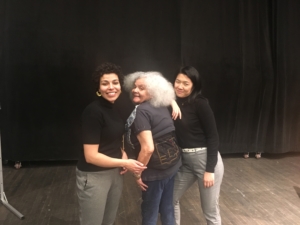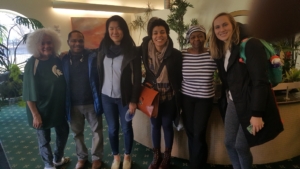I came into Challenge #2 (a partnership with the Hannan Center) thinking that I would really struggle with this one. The Hannan Center is a holistic community center that seeks to preserve the dignity and enhance the quality of life of seniors in Michigan. In Challenge we use the Design thinking process, the first step of which is Empathy. As someone who doesn’t interact with any older adults in their life, I entered into this with lots of uncertainty and apprehension. I thought, how could I empathize with- let alone create programming to help- an older adult. The prompt for this Challenge was to tackle how to improve assistive technology/ devices and how to improve one’s relationship with their assistive device. Through the design thinking process, my team (comprised of Hind Ourahou, Kenzie Kramer, and Jarrett Sanders) and I conducted empathy interviews with community members. This is where we met Miss Rose.
During the interview, Miss Rose shared that she was always curious about drafting. But because she is 1.) a woman and 2.) a person of color, was denied the opportunity to learn it in high school. I was touched to hear this and along with my team, we decided that we must help this lady learn how to draft!
Over the course of a few weeks, I spent several sessions working with Miss. Rose designing, ideating, and drafting her dream home (complete with a 4 sided fireplace and plant room). We covered the drafting basics such as how to use a T-square, choosing a scale, and how to poche.

Through our one-on-one drafting sessions together, we shared stories and laughed a lot. I also learned that although Miss Rose is in perfect health, she does suffer from back pain when she walks long distances. We discussed, researched, and tested different back braces. To respond to our original question of that relationship between a person and their assistive device, my team and I decided that the best way to approach improving assistive devices for Miss Rose was to personalize her back brace and embroider this drafted dream home onto said back brace.
With the help of a seamstress, my teammate Hind created a beautiful, ornate sleeve to be fitted over the back brace. This ornate back brace could be very comfortably worn over clothes. My team and I then used this process that we went through as a prototype to model an arts programming curriculum for the Hannan Center. The concept was essentially to connect skilled craftsmen with older adults and other beginners to the craft, who seek to learn or improve on an artistic skill. The goal is to not only improve one’s relationship with their assistive device through hands-on personalization, but also to encourage a transferral of experiences and skills, thus forming intergenerational relationships.

As with all Challenges, there was a presentation and this Challenge came to an end in late-January. I’m very proud of the work my team and I accomplished and cherish the camaraderie we shared, but my greatest- though initially unexpected- takeaway from this process is my friendship with Miss Rose.

